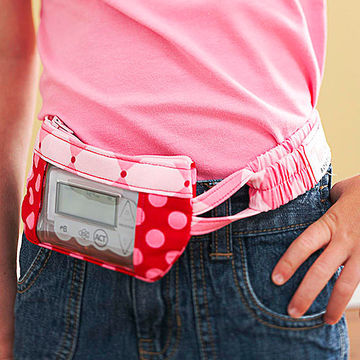Recent innovations may reduce the round-the-clock job of managing type 1 diabetes in children.

If a child has type 1 diabetes (T1D), his immune system attacks and destroys cells in the pancreas that produce insulin, the hormone that converts food into energy. Before the 1920s, the diagnosis of T1D was a death sentence. In less than a century, technology has developed so greatly that not only can the 15,000 kids diagnosed annually with T1D in the U.S. survive, with careful management, they can also thrive and live long, productive, happy lives.
Constant monitoring
Without enough insulin, blood glucose (sugar) levels will rise to dangerous amounts, and over time, this can cause devastating long-term complications such as kidney failure, heart disease, lower-limb amputations, and blindness in adults.
It’s essential for kids with T1D to have their blood sugar levels checked around the clock. Six or more times a day, parents prick the child’s fingertip for a drop of blood and place it on a special test strip in a blood glucose meter. With that reading, a child then takes insulin, eats, or modifies activity to help keep the blood sugar at a normal level.
But T1D management is changing, even as you read this story. “The progress of new technologies is rapid and ongoing,” says Parents advisor Lori Laffel, M.D., M.P.H., chief of the Pediatric, Adolescent, and Young Adult Section at the Joslin Diabetes Center in Boston. “Diabetes discoveries are moving at revolutionary speed.”
Current Treatment
A child with T1D must inject insulin many times a day or use an insulin pump, which delivers the insulin through a tube connected to the child’s abdomen. The exact number of injections varies from kid to kid, but a child typically needs one before meals or whenever she eats, or when her blood sugar level is elevated. For decades, insulin has been delivered through syringes or insulin pens. In 1976, inventor Dean Kamen introduced the insulin pump, an alternative to injections. This beeper-sized computerized device is often worn on a belt or in a pocket. It delivers an ongoing low (basal) dose of insulin into the body through a small tube.
Whenever a child wearing a pump eats or has an elevated blood sugar level, she (or an adult) pushes a button on the pump to get an extra amount of insulin called a bolus. The site of the tube needs to be changed (usually by a parent) every two to three days to prevent infection, and also because it’s harder to control glucose levels when insulin is always infuses into the same area.
There are also small tubeless “pod” pumps that combine the pumping mechanism, needle, and insulin reservoir into one unit that directly attaches to the body.
New Developments and Research
As of 2006, a device called a continuous glucose monitor (CGM) became available to measure sugar levels. It works much like an insulin pump and attaches to the body in the same way.
“When you take insulin, you walk a tightrope between taking too little and taking too much,” says Aaron Kowalski, Ph.D., vice president for treatment therapies at JDRF, formerly known as the Juvenile Diabetes Research Foundation. “The body of a person without diabetes regulates blood sugar very well. A person with diabetes does it by injections or wearing a pump, which is actually quite hard.”
But with the CGM, a small glucose-sensing device worn on the abdomen or arm, you get a glucose reading all the time, rather than the little blips of information you get with the finger sticks and glucose meter. It still requires daily finger pokes but can add valuable additional information, such as whether the glucose levels are going low, according to JDRF.
This is great news, especially if you have a 1-year-old with T1D and pricking his or her finger up to 12 times a day can be harrowing, or a kid with T1D who eats unexpectedly, or not at all. “You can pull this device out of your pocket and check it anytime,” says Dr. Kowalski. “You get numbers. You get high and low alarms. It’s reducing the risk of long-term complications. That’s a big, big advance.”
Looking Ahead
Diabetes management will look very different in the coming years. Over the next decade, it’s expected that the technology will exist to create working pancreatic beta cells — the ones that produce insulin — from other cells and either transplant them into a child with T1D, or administer a drug that turns their own cells into working beta cells that make insulin, according to JDRF. All over the country, human trials are also underway for insulin that’s inhaled or taken by pill rather than injected, though it’s not yet known when they will be available.
Perhaps the most exciting, says Dr. Kowalski, is the possibility — in the next three to four years — of an artificial pancreas that delivers insulin based on a glucose level measured by a CGM that communicates with an insulin pump. It’s considered to be almost a “bionic” pancreas that monitors itself, as the body should.
Probably within the next year, says JDRF, we’ll see a device that’s currently under review by the FDA called a low-glucose suspend system. Sometimes called an introductory artificial pancreas, it could automatically reduce the amount of low blood sugars kids with diabetes experience. When blood sugar is low for a certain amount of time, and the child doesn’t respond to CGM alarms, her insulin pump suspends for a few hours. This could go a long way to help kids with T1D (and their parents) sleep better at night.
“People have been waiting a long, long time for these developments,” says Dr. Kowalski. “The research is going to transform diabetes. It’ll make parents’ lives easier. It’ll make people with diabetes healthier. It’s going to be a great thing.”





